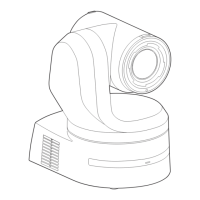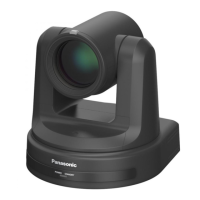Streaming format
Make settings for H.264 images for use in RTMP/RTMPS
transmission.
The setting is confirmed with the [Set] button.
Refer to the explanation for [H.264] (→ page 127) for information
about [Profile type], [Image capture size], [CBR/VBR], [Frame rate],
and [Max bit rate(per client)].
<NOTE>
• [Streaming format] settings cannot be changed during RTMP/
RTMPS transmissions.
• Set the [Streaming format] to the settings recommended for the
transmission destination server. Visit the publisher’s website or
contact them about the recommended values.
• When [IP(UDP)] of [Tracking Data Output] is set to [On], video
transmission via IP may be delayed or the video may suffer frame
loss. (→ page 165)
We recommend [IP(UDP)] of [Tracking Data Output] is set to [Off]
during RTMP/RTMPS transmission.
z SRT
Make SRT transmission settings.
<NOTE>
• When starting SRT transmissions in the [Listener] mode, set the
decoder and application to [Client(Caller)] mode and set the following
URL:
srt://[unit’s IP address]:[value set in Client(Caller) port]
• When performing SRT transmissions in the [Client(Caller)] mode, set
the IP address and port number of the decoder and application to
[Destination IP address(IPv4)] and [Destination port], and then click
the [start] button for [SRT/MPEG2-TS/RTMP] in the live screen [Live].
Common setup
The setting is confirmed with the [Set] button.
Mode [Client(Caller), Listener]
Selects the method to connect to the SRT compatible decoder or
service.
Client(Caller) Specify the transmission destination IP address and port
number when starting transmission from this unit.
Listener Specify the listener port when awaiting the external
request to start transmission.
Factory settings: Listener
Destination IP address(IPv4)
When [Client(Caller)] is set in [Mode], enter the IP address.
Images and audio will be sent to the specified IP address.
Factory settings: 192.168.0.3
<NOTE>
• Only IPv4 can be set as the IP address.
Destination port [1 to 65535]
When [Client(Caller)] is set in [Mode], enter the port number (used
when transmitting images from this unit).
Connection is to the specified port number.
Factory settings: 7002
Stream ID
When [Client(Caller)] is set in [Mode], enter the Stream ID.
The information entered is notified to the connection destination when
SRT transmission is started.
If the [InsertTemplate] button is clicked, the following template is
inserted in the input fields.
#!::m=publish,r=PanasonicStream
• The following characters can be displayed.
Numeric characters 0123456789
Alphabetical
characters
(upper and lower
cases)
ABCDEFGHIJKLMNOPQRSTUVWXYZ
abcdefghijklmnopqrstuvwxyz
Symbols !”#$%’()=-~^|\`@[]{}
*
:+;<>,.?/\_
Factory settings: #!::m=publish,r=PanasonicStream
Client(Caller) port [1 to 65535]
When [Listener] is set in [Mode], enter the port number (used when
this unit is waiting for a connection).
The following port numbers are used by the unit so they cannot be
used.
20, 21, 23, 25, 42, 53, 67, 68, 69, 80, 110, 123, 161, 162, 443, 546,
547, 554, 995, 5960 to 5985, 7960 to 8060, 10669, 10670, 11900,
59000 to 61000
Factory settings: 2020
TTL/HOP Limit
The same as [H.264] [Multicast TTL/HOPLimit] (→ page 129).
Factory settings: 254
Latency
Sets the time between when images and audio are sent and when
they are played on the receiving device in a range between 0 and
99999 (ms).
Factory settings: 120
<NOTE>
• In some cases, the set time is not guaranteed depending on the
network band.
131
Web screen configurations (continued)

